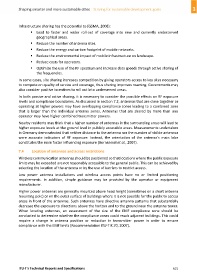Page 631 - Shaping smarter and more sustainable cities - Striving for sustainable development goals
P. 631
Infrastructure sharing has the potential to (GSMA, 2008):
Lead to faster and wider roll‐out of coverage into new and currently underserved
geographical areas.
Reduce the number of antenna sites.
Reduce the energy and carbon footprint of mobile networks.
Reduce the environmental impact of mobile infrastructure on landscape.
Reduce costs for operators.
Optimize the use of the RF spectrum and increase data speeds through active sharing of
the frequencies.
In some cases, site sharing increases competition by giving operators access to key sites necessary
to compete on quality of service and coverage, thus sharing improves roaming. Governments may
also consider positive incentives to roll out into underserved areas.
In both passive and active sharing, it is necessary to consider the possible effects on RF exposure
levels and compliance boundaries. As discussed in section 7.2, antennas that are close together or
operating at higher powers may have overlapping compliance zones leading to a combined zone
that is larger than the individual antenna zones. Antennas that are shared by more than one
operator may have higher combined transmitter powers.
Nearby residents may think that a higher number of antennas in the surrounding areas will lead to
higher exposure levels at the ground level in publicly accessible areas. Measurements undertaken
in Germany demonstrated that neither distance to the antenna nor the number of visible antennas
were accurate indicators of RF exposure. Instead, the orientation of the antenna’s main lobe
constitutes the main factor influencing exposure (Bornkessel et al., 2007).
7.4 Location of antennas and access restrictions
Wireless communication antennas should be positioned so that locations where the public exposure
limits may be exceeded are not reasonably accessible to the general public. This can be achieved by
selecting the location of the antenna or by the use of barriers to restrict access.
Low power antenna installations and wireless access points have no or limited positioning
requirements. In addition, simple guidance may be provided by the operator or equipment
manufacturer.
Higher power antennas are generally mounted above head height (sometimes on a short antenna
mounting pole) or on the outer surface of buildings where it is not possible for the public to access
areas in front of the antennas. Such antennas have directive antenna patterns that substantially
decrease the exposure to directions above the horizon and to the ground near the antenna tower.
When locating antennas, an assessment of the size of the EMF compliance zone should be
conducted to determine whether the compliance zones could reach adjacent buildings. This could
require a change in antenna position or reduction in transmitter power in order to ensure
compliance with the EMF limits (Recommendation ITU‐T K.70, 2007).
ITU‐T's Technical Reports and Specifications 621

